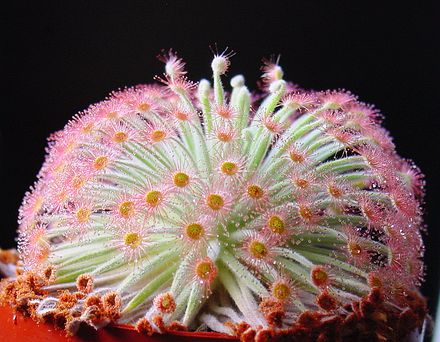Drosera
Drosera, which is commonly known as the sundews, is one of the largest genera of carnivorous plants, with at least 194 species.[1] These members of the family Droseraceae lure, capture, and digest insects using stalked mucilaginous glands covering their leaf surfaces. The insects are used to supplement the poor mineral nutrition of the soil in which the plants grow. Various species, which vary greatly in size and form, are native to every continent except Antarctica.[2]
Charles Darwin performed much of the early research into Drosera, engaging in a long series of experiments with Drosera rotundifolia which were the first to confirm carnivory in plants.[3] In an 1860 letter, Darwin wrote, “…at the present moment, I care more about Drosera than the origin of all the species in the world.”[4]
Both the botanical name (from the Greek δρόσος: drosos = "dew, dewdrops") and the English common name (sundew, derived from Latin ros solis, meaning "dew of the sun") refer to the glistening drops of mucilage at the tip of the glandular trichomes that resemble drops of morning dew. The Principia Botanica, published in 1787, states “Sun-dew (Drosera) derives its name from small drops of a liquor-like dew, hanging on its fringed leaves, and continuing in the hottest part of the day, exposed to the sun.”[5]
Sundews are perennial (or rarely annual) herbaceous plants, forming prostrate or upright rosettes between 1 and 100 cm (0.39 and 39.37 in) in height, depending on the species. Climbing species form scrambling stems which can reach much longer lengths, up to 3 m (9.8 ft) in the case of D. erythrogyne.[6] Sundews have been shown to be able to achieve a lifespan of 50 years.[7] The genus is specialized for nutrient uptake through its carnivorous behavior, for example the pygmy sundew is missing the enzymes (nitrate reductase, in particular)[8]that plants normally use for the uptake of earth-bound nitrates.
Although they do not form a single strictly defined growth form, a number of species are often put together in a further group:
Sundews are characterised by the glandular tentacles, topped with sticky secretions, that cover their laminae. The trapping and digestion mechanism usually employs two types of glands: stalked glands that secrete sweet mucilage to attract and ensnare insects and enzymes to digest them, and sessile glands that absorb the resulting nutrient soup (the latter glands are missing in some species, such as D. erythrorhiza). Small prey, mainly consisting of insects, are attracted by the sweet secretions of the peduncular glands. Upon touching these, the prey become entrapped by sticky mucilage which prevents their progress or escape. Eventually, the prey either succumb to death through exhaustion or through asphyxiation as the mucilage envelops them and clogs their spiracles. Death usually occurs within 15 minutes.[3] The plant meanwhile secretes esterase, peroxidase, phosphatase and protease enzymes.[9]These enzymes dissolve the insect and free the nutrients contained within it. This nutrient mixture is then absorbed through the leaf surfaces to be used by the rest of the plant.


